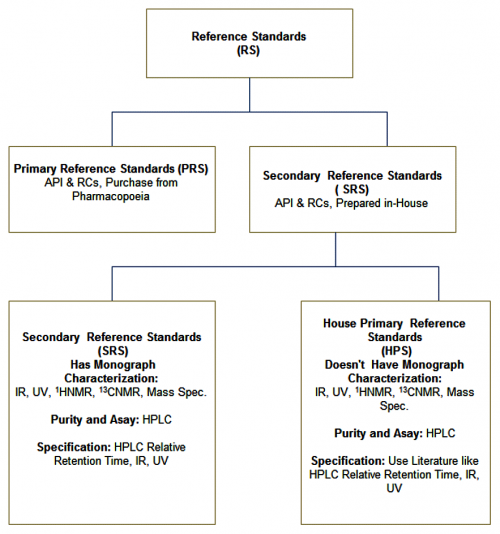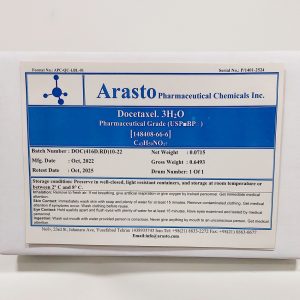Description
Description
(USP 44)
- Drug Substance General Information (ICH 3.2.S.1)
1.1. Nomenclature (ICH 3.2.S.1.1)
International non-proprietary name: Capecitabine (Brand Name: Xeloda, Sandoz Pharmaceuticals, Switzerland)
Compendial name: Capecitabine
Chemical name: Pentyl [1-(3,4-dihydroxy-5-methyltetrahydrofuran-2-yl)-5-fluoro-2-oxo-1H-pyrimidin-4-yl]carbamate
Arasto’s code: CAP
CAS Registry Number: [154361-50-9]
- Drug Substance General Information (ICH 3.2.S.1)
1.2 Structure (ICH 3.2.S.1.2)

Empirical formula: C15H22FN3O6
Molecular Weight: 359.35 g/mol
- Drug Substance General Information (ICH 3.2.S.1)
1.3. General Properties (ICH 3.2.S.1.3)
Capecitabine is a white crystalline substance. It is an orally-administered chemotherapeutic agent used in the treatment of metastatic breast, colorectal and esophageal cancers. It is soluble in water and most organic solvents except saturated hydrocarbons. Capecitabine pKa has been calculated to be ca. 8.7 (http://meloun.upce.cz/docs/publication/275.pdf. LD50of Capecitabine has been reported (2000 mg/kg oral rat,http://ctep.cancer.gov/ branches/pmb/ msds/712807-Capecitabine_Xeloda_31.8.06.pdf).
The determination of purity and assay of APIs require comparison of the product with their respective Reference Standards (RS) and Related Compounds (RC or known impurities). Accordingly, ICH regulations on the purity and assay of reference standard and related compounds are clearly defined and must be followed by drug substance and drug product manufacturers.
According to ICH Q7, 11.1 there are 3 types of standards. This is summarized in the following chart and discussed in detail below.

The impurities provided in the following table represent Secondary Reference Standards (SRS) that are prepared in-house by synthesis or by isolation. Each SRS has undergone extensive characterization (IR, UV, 1HNMR, 13CNMR. Mass Spec) and determination of its purity and assay (HPLC). For specification of the SRS of those products that have a monograph, the SRS is compared with a pharmacopoeia Primary Reference Standard (UV, HPLC retention time). For specification of those products that do not have a monograph (known as House Primary Standard), we compare their UV ε or ג /max, IR major absorptions, 1HNMR d(ppm), 13 CNMR d(ppm) or HPLC retention time with values reported in the chemical literature for these compounds.

- Primary and Secondary Reference Standard (ICH 3.2.S.5)
5.1. Active Pharmaceutical Ingredient
Primary Reference Standard for capecitabine is available from United States Pharmacopoeia. We will use a Secondary Reference Standard (previously referred to as Working Standard) for direct control of all batches of capecitabine.
As per ICH (Q7, 11.1) and ICH (Q6, 2.11, 3.2, 3.3) the Secondary Reference Standards, which include the API and its Related Compounds, must be examined for their proof of structure (characterization), assay and purity and specification (identification by comparison). Furthermore, ICH Guideline on the Preparation of Common Technical Document (Q4M) requires that the data obtained from characterization, assay and purity and specification must be included in section 3.2.S.3.2 for Related Compounds (already discussed in that section) and section 3.2.S.5 of the DMF for the API. To this end, the Secondary Reference Standards of the API capecitabine has undergone extensive characterization (UV, IR, 1 H NMR, 13C NMR, and Mass Spec) to assure its structure, assay and purity (HPLC and/or titration) and specification (comparison of its HPLC retention time and UV ג /max with USP Primary Reference Standard.
The Secondary Reference Standard for capecitabine was produced from a released batch of capecitabine by subjecting it to an additional crystallization from the final solvent system used in the production of the API to avoid the possibility of other polymorph formation.
SPECIFICATION OF ANALYSIS
| Product: Capecitabine | CAS No.: 154361-50-9 | Spec. No.: APC-QC-SPEC-323-00 | ||
| Issue Date: Apr, 2023 | Valid up to: Apr, 2024 | Reference: USP44 | ||
| Tests | Specifications | |||
| Description | White to off white crystalline powder. | |||
| Solubility | Freely soluble in methanol; soluble in acetonitrile and in alcohol; sparingly soluble in water. | |||
| Identification | A: Infrared Spectroscopy B: The retention time of the major peak of the Sample solution corresponds to that of the Standard solution, as obtained in the assay. | |||
| Specific Rotation | +96.0º to +100.0° | |||
| Water determination | NMT 0.3% | |||
| Residue on ignition | NMT 0.1% | |||
| Residual Solvents | Methanol: NMT 3000ppm (Class II) Dichloromethane: NMT 600ppm (Class II) Toluene: NMT 890ppm (Class II) n-Heptane: NMT 5000ppm (Class III) | |||
| Organic impurities (HPLC) | Capecitabine related compound A: NMT 0.3% Capecitabine related compound B: NMT 0.3% 2,3-Di-O-acetyl-5-deoxy-5-fluorocytidine: NMT0.1% 5-Deoxy-5-fluoro-N4-(2-methyl-1-butyloxycarbonyl)cytidine + 5-Deoxy-5-fluoro-N4-(3-methyl-1-butyloxycarbonyl)cytidine: NMT 0.5% [1-[5-Deoxy-3-O-(5-deoxy-β -D-ribofuranosyl)- β-D-ribofuranosyl]-5-fluoro-2-oxo-1,2-dihydropyrimidin-4-yl]-carbamic acid pentyl ester: NMT 0.3% [1-[5-Deoxy-2-O-(5-deoxy-β -D-ribofuranosyl)- β-D-ribofuranosyl]-5-fluoro-2-oxo-1,2-dihydropyrimidin-4-yl]-carbamic acid pentyl ester: NMT 0.2% Capecitabine related compound C: NMT 0.3% [1-[5-Deoxy-3-O-(5-deoxy-α -D-ribofuranosyl)-β -D-ribofuranosyl]-5-fluoro-2-oxo-1,2-dihydropyrimidin-4-yl]-carbamic acid pentyl ester: NMT 0.3% 2,3-Di-O-acetyl-5-deoxy-5-fluoro-N4-(pentyloxycarbonyl)cytidine: NMT 0.1% Individual unspecified impurity: NMT 0.1% Total impurities: NMT 1.5 % | |||
| Assay (HPLC) | 98.0% to 102.0% (on the anhydrous and solvent-free basis) | |||
| Prepared by: M. Shahbazi, B.Sc.Chem. | Checked by: A. Forghani, B.Sc.Chem. | |||
| Approved by: F. Javadizadeh, M.Sc.Chem. | ||||
| Storage: Preserve in tight containers, store at controlled room temperature. | ||||





